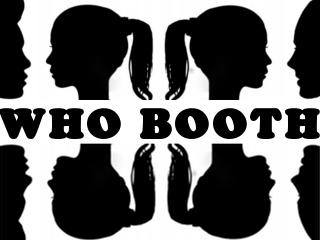Who Booth
Allison Eve Zell
WHO BOOTH is an interactive installation that maps the aspirations of adolescent girls today to inspirational women throughout history, using custom software to merge the girls with their new heroines.

WHO BOOTH is essentially a repurposed photo booth housing an experience of music, text, and video in effort to connect girls with solid role models in a fun way. Artifacts are created to take the experience beyond the booth itself. A video of the girls portraying their new heroines can be emailed and/or posted onto social sites, and a printed postcard comes out of a slot (like a traditional photo booth) for the girls to take home and/or mail, the old fashioned way.
Background
WHO BOOTH design research included reading "Reviving Ophelia" by Mary Pipher, "How Girls Thrive" by JoAnn Deak, Ph.D. with Dory Adams, and a recent doctoral thesis called "The contribution of role models to the self-esteem of African American and Caucasian Adolescent Girls" by Michelle P. Clark. Other topics researched and implemented include Experiential Learning and Positive Psychology's "Values in Action Inventory of Strengths": a cross-cultural psychological assessment measure of character strengths.
User Scenario
Enter WHO BOOTH, close the curtain behind you, and approach the touchscreen to choose a quality you aspire to be: brave, just, down-to-earth, wise, kind, or out-of-this-world. You choose "brave" and begin an experience of a brave woman, say, Rosa Parks. A song from the civil rights era plays as you read an anecdote about her out loud in first person, then trace her signature with your finger, and upon the final stroke, your face appears and slowly turns into Rosa Parks' face. Make a video of your newly merged self, watch and share it - as a movie or a still on a postcard.
Implementation
WHO BOOTH is made of wood, metal pipe, fabric, a touchscreen monitor, software, and video/sound/image/text assets. Its software builds upon Kyle MacDonald and Arturo Castro's Face Substitution OF app, which builds upon the C++ API Face Tracker library built by Jason Saragih (Johnny Lu served as my openframeworks). The booth will live in The Lower Eastside Girls Club 30 000 sq foot facility on Avenue D, opening in the Fall of 2013. I'll teach the girls there to curate and adjust the code for the booth as they teach me to perfect it (many girls have already helped a ton: Anya, Saskia, Clara, Isabel, Lucy, India, Ivory, Wisdom, Amanda, and Amaya). Then the plan is to create gender neutral versions for art and science museums targeting adolescents, then possibly to scale it: creating an online version for adolescents around the world.
Background
WHO BOOTH design research included reading "Reviving Ophelia" by Mary Pipher, "How Girls Thrive" by JoAnn Deak, Ph.D. with Dory Adams, and a recent doctoral thesis called "The contribution of role models to the self-esteem of African American and Caucasian Adolescent Girls" by Michelle P. Clark. Other topics researched and implemented include Experiential Learning and Positive Psychology's "Values in Action Inventory of Strengths": a cross-cultural psychological assessment measure of character strengths.
User Scenario
Enter WHO BOOTH, close the curtain behind you, and approach the touchscreen to choose a quality you aspire to be: brave, just, down-to-earth, wise, kind, or out-of-this-world. You choose "brave" and begin an experience of a brave woman, say, Rosa Parks. A song from the civil rights era plays as you read an anecdote about her out loud in first person, then trace her signature with your finger, and upon the final stroke, your face appears and slowly turns into Rosa Parks' face. Make a video of your newly merged self, watch and share it - as a movie or a still on a postcard.
Implementation
WHO BOOTH is made of wood, metal pipe, fabric, a touchscreen monitor, software, and video/sound/image/text assets. Its software builds upon Kyle MacDonald and Arturo Castro's Face Substitution OF app, which builds upon the C++ API Face Tracker library built by Jason Saragih (Johnny Lu served as my openframeworks). The booth will live in The Lower Eastside Girls Club 30 000 sq foot facility on Avenue D, opening in the Fall of 2013. I'll teach the girls there to curate and adjust the code for the booth as they teach me to perfect it (many girls have already helped a ton: Anya, Saskia, Clara, Isabel, Lucy, India, Ivory, Wisdom, Amanda, and Amaya). Then the plan is to create gender neutral versions for art and science museums targeting adolescents, then possibly to scale it: creating an online version for adolescents around the world.


